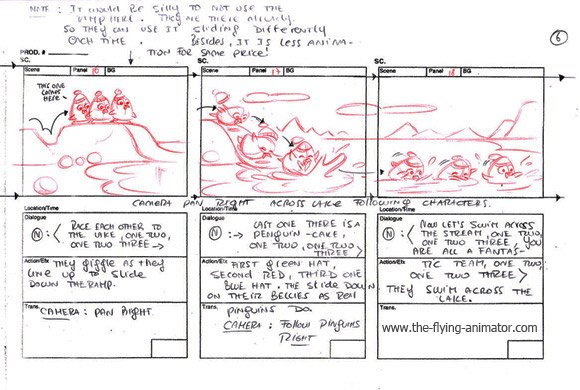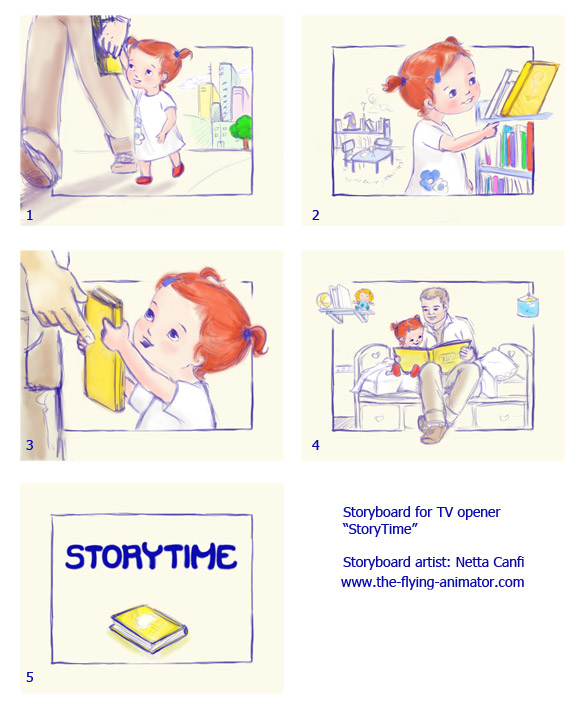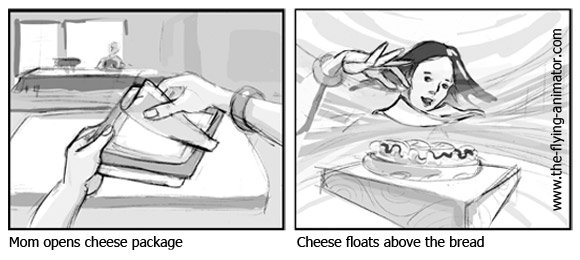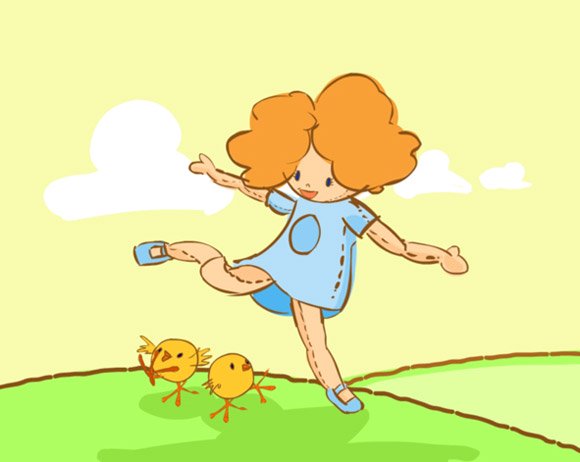What is a Storyboard?
The role of the storyboard in a TV or movie production
A storyboard is a plan, a way of figuring out the story of the film before you put in the enormous amount of work of the animation itself.
Basically, it is the story of the movie drawn in pictures, very much like a comic strip.
 Storyboard example: Numbers Around the Globe, BF-TV Channel. Story artist: Fernando Yache
Storyboard example: Numbers Around the Globe, BF-TV Channel. Story artist: Fernando YacheFrom a storytelling point of view, a storyboard for film or TV needs to answer two questions:
- What is happening?
- What is the best way to SHOW IT?
The Storyboard as a production tool
What you need to consider when drawing a storyboard, is who is going to use it, and how.
This piece of paper is a working document. It passes many hands during production, and each professional will need to understand different things from it.
Let's see just what is a storyboard for each person in the production:
The Director
First of all, the director sits with the story-artiste to figure out the story itself, and the cinematic language.
They take the script and turn it into visual sequences. Attached to each pane you'll usually find a description of the camera (close-up, long shot, pan left, ect.,), the relevant piece of dialogue, and sometimes a verbal description of the action in the scene.
A storyboard alone is hard to time . A very likely next step is to put the panes on a timeline and turn them into a videoboard ("animatique"), with a guide soundtrack. I'll discuss videoboards in another article, though, let's just stick to paper here.
Once the director manages to show and tell the story on paper, the storyboard starts traveling thru the production pipeline:
Designers
Designers break it down to which characters they need to design, and make a list of props, backgrounds and anything else that needs to be drawn or modeled.
 Opener for TV series "StoryTime", for the Hop! Channel. Story artist: Netta Canfi
Opener for TV series "StoryTime", for the Hop! Channel. Story artist: Netta CanfiFrom this storyboard we learn that we need to design:
Characters:
- girl
- dad
- close-up of dad's hand (This sort of thing is very important! A body part shown in close-up is usually a different rig or design in animation.)
Props:
- a book
- the same book- open
- the book - close up with the show's logo (title) on it
Backgrounds:
- library
- street
- bedroom
More professionals in the production will make similar lists, according to what the storyboard means for them:
Technical Directors (TD)
In a computer animation production, the riggers look at the boards and analyze what the characters have to DO, how they need to MOVE.
For example, they might realize that they need to build a different rig for a particular sequence, or discover that a major character has LONG HAIR!
Special Effects Crews
Storyboards started in the animation world but were quickly adopted by live-action productions, especially when complicated special effects came on the scene.
In this TV commercial, the special effects people studied the storyboard to see if they need a wind machine, a blue screen, or a wire to hang the cheese from...
 TV commercial storyboard. Story artist: Netta Canfi
TV commercial storyboard. Story artist: Netta CanfiSoundtrack Designers
The soundtrack designers look at the story panes and figure out which sounds they need to record. For example, if the storyboard shows a character walking, they make a note to record the sound of footsteps.
The list goes on and on -
Producers (they take everybody else's lists and use them to estimate the budget), photographers, costume designers, set builders, and of course the animators themselves - all use the storyboard, together with the script, as the blueprint of the film.
Each will glean different information from the same piece of paper.
Types of Storyboards
There are as many types of storyboards as there are aspects of production.
You could come across:
- A rough jotted down storyboard that just tries to figure out the story.
- Concept storyboards, rich in color and detail, that search for the atmosphere of the film.
- Color storyboards that map out the entire film according to which colors dominate which sequence.
- Animation storyboards, that can be as detailed as keyframes of the animation itself.
- Presentation storyboards, very elaborate and finely drawn, designed to sell an idea to a client.
 Concept illustration - "Buba Yemima" ( the doll Yemima) for the Hop! Channel. Illustrator: Netta Canfi
Concept illustration - "Buba Yemima" ( the doll Yemima) for the Hop! Channel. Illustrator: Netta CanfiWhich brings us to an important point you must remember:
You really cannot show it just to anyone.
What does this storyboard mean?
Most types of boards are a kind of short hand: you need to be able to understand what you "read".
You yourself may perfectly understand the few lines and squiggles you jotted down to plan a piece of animation, but someone else might not have the first clue as how to look at it.
Many storyboard meetings take place with the director or story artists playing and explaining the pictures to the production team. More often than not, a storyboard needs some background explanations and can't stand by itself.
Also, when dealing with a client who is perhaps paying for the animation, but has never made a film - remember that people may not be able to imagine how a sequence drawn on paper will look like on the screen at the end.
My rule of thumb:
The more people need to use the storyboard - the more elaborate and communicative it needs to be.
If it's a quick sketch you made for yourself alone - just make sure YOU will be able to understand it a week after you've drawn it.
If it's for many other people to use - make it as communicative as possible, even print the text under the panes to make sure it's readable.
Remember that you won't be in the room to explain what you meant!
Learn to draw storyboards
I've put together a list of a books that I use when I need a guideline for drawing a storyboard.
They are about storyboarding, learning cinematography and planning layouts, and also a couple of eye-feasts - check them out!

Free - Download a blank storyboard template
Learning to Draw Perspective is very useful for storyboarding
More in the Theory Section: How does computer animation work?
Articles
How Does computer Animation Work
Character Design - A Stroll with Famous Felines
Making Animation
Recording Voice Talents for Animation
How to Draw A Cat Tutorial - step by step!
